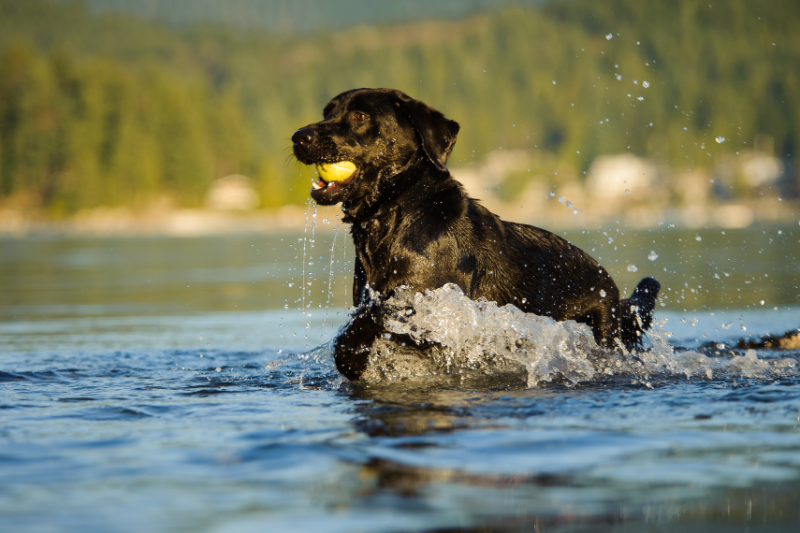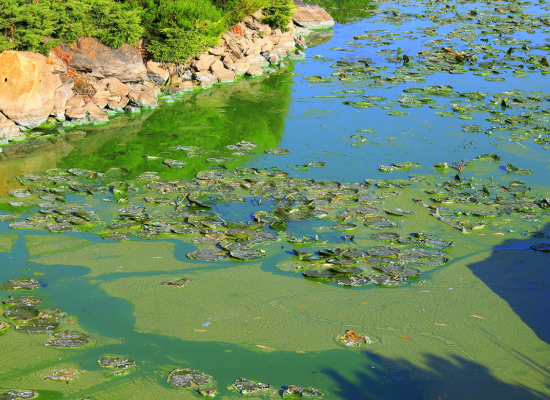
Unlike cats, who usually turn their noses up at getting wet, dogs often love water – whether that’s a paddling pool in the back garden or your local lake.
But water does come with its risks and hazards, so it’s important to know about the dangers before letting your dog go swimming.
Is swimming good for dogs?
Exercise is very important for dogs, especially certain breeds like Border Collies or Springer Spaniels.
Swimming can be a great part of their weekly exercise, especially in the summer months. This helps your dog move their muscles while also having fun in the water.
Swimming can be especially helpful for dogs with painful, stiff or weak joints, as it lets them move around with less of the stress of gravity on them.
The dangers of dogs swimming
It’s lovely to see our dogs enjoy the water and stay healthy, but swimming can lead to some problems for their safety or health.
These dangers include:
- Strong currents: in moving water, like seas and rivers, currents can quickly get a hold of your dog and sweep them away.
- High waves: high or powerful waves in the sea can overwhelm them and increase the risk of drowning.
- Contaminated water: water containing chemicals or harmful bacteria could hurt your dog.
- Sharp debris: litter like discarded trolleys and garden tools could cut or trap your dog.
Dog swimming safety tips
Let's run through the best ways to keep your dog safe in the water.
Pick the right spots
There’s good spots and bad spots for dog swimming. The better spots include:
- lakes
- slow rivers
- private pools
- the coastal part of the sea
The more dangerous spots that you should avoid include:
- canals
- fast rivers
- rough seas
- the deep sea
- reservoirs
But even in popular spots, it’s very important to have a look at the body of water before letting your dog jump in.
Look out for things like:
- debris
- high winds
- red lifeguard flags
- prohibited signs and warnings
- completely stagnant water
If you’re unsure of the depth of the water, use a stick to see if you can touch the bottom.
If you can’t, there’s no knowing how deep the water is - and it may be dangerous for your dog to swim in.
Keep an eye on your dog
Even if the water seems safe and your dog is happy, don’t leave them unsupervised.
Things can change fast in the water, and it only takes one swift current or piece of debris to put your dog in danger.
Don’t let your dog swim at night
If you’re out on a late-night walk with your dog, stick to safe paths and pavements.
Without proper lighting, it’s dangerous to let your dog go swimming, as you can lose sight of them easily.
Avoid still water
All sorts of things can make their way into water, including:
- harmful bacteria (such as Leptospirosis)
- chemicals
- dangerous debris (e.g. broken glass)
Certain kinds of contaminated water can even be life-threatening to your dog.
It’s best to avoid completely still and isolated bodies of water, as they’re more likely to be contaminated with one or more of these hazards.
Avoid letting them swim in water near power stations, landfills or factories, as there’s a chance it’s contaminated with chemicals or bacteria.
Avoid blue-green algae

Blue-green algae can live in many kinds of bodies of water in the UK, including lakes, seas, rivers, ponds and so on.
This can be fatal to dogs, so it’s very important to keep an eye out for it before letting your dog swim.
Look out for sharp debris
Unfortunately, people throw all sorts of things in bodies of water.
Some of these items (old trolleys, shrapnel, etc.) can become dangerous for both people and dogs when swimming.
If you see any litter or debris sticking out of the water or the body of water is surrounded by a lot of litter or debris, it’s best to avoid it.
Check out Scotland’s Fire And Rescue dog water safety advice for more information on how you can keep your pooch safe.
Swimming in a private pool
If you have a pool for your dog to swim in, there are still some safety precautions to take:
- be cautious about how much chlorine you’ve put in the pool
- teach your dog how to get out of the pool safely
- don't leave your dog unattended in or by the pool
Signs that your dog is drowning
Key signs that your dog is drowning include:
- being under the water for longer than usual
- barking, crying or howling in the water
- seeming unconscious or immobile
Once your dog is out of the water, other signs that they were experiencing drowning include:
- shortness of breath
- vomiting
- pale or blue-tinged gums
- foamy or bloody saliva
Secondary drowning
Even if your dog looks like they’re back to normal after almost drowning, they can still suffer from ‘secondary drowning’.
This happens when there’s a build-up of fluid in the lungs, which then causes respiratory or breathing issues.
Signs of secondary drowning in dogs include:
- coughing
- wheezing
- drooling
- difficulty breathing
- blue-tinged gums
Take your dog to the vet immediately if you think they’re suffering from secondary drowning.
What to do if you think your dog is drowning
It’s important to act fast and know the right steps if you think your dog is drowning or experiencing secondary drowning.
- Get them on land: if your dog is still in the water or struggling to keep its head above water, get them out straight away.
- Check their airways: make sure there isn’t anything blocking their airways, such as seaweed or litter.
- Start CPR: if your dog isn’t breathing and you can’t feel a heartbeat, begin CPR by lying them on their right side (or back if they’re a flat-chested breed) and giving them chest compressions, followed by rescue breaths.
- Keep CPR consistent: give your dog 30 chest compressions, followed by two rescue breaths. Continue this until they start breathing again.
- Get to the vet: once your dog is breathing again, take them straight to the vet.
What to do if you think your dog has ingested contaminated water
Signs that your dog has ingested contaminated water include:
- vomiting
- diarrhoea
- dizziness
- lethargy
Take your dog to the vet immediately if you think they’ve drank contaminated water.


